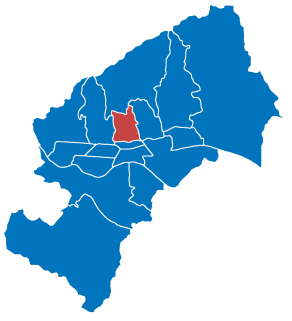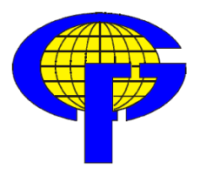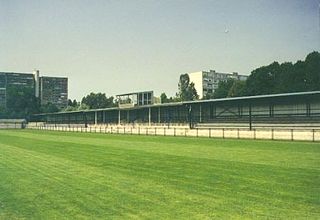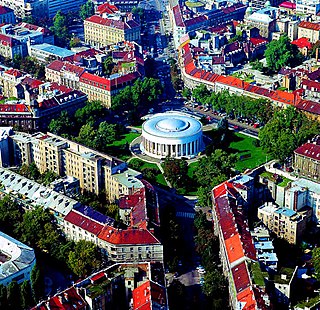
Zagreb County is a county in central Croatia. It surrounds – but does not contain – the nation's capital Zagreb, which is a separate territorial unit. For that reason, it is often nicknamed "Zagreb ring". According to the 2011 census, the county has 317,606 inhabitants.

The State of Slovenes, Croats and Serbs was a political entity that was constituted in October 1918, at the end of World War I, by Slovenes, Croats and Serbs resident in what were the southernmost parts of the Austro-Hungarian Empire. Although internationally unrecognized, this was the first incarnation of a Yugoslav state founded on the Pan-Slavic ideology. Thirty-three days after it was proclaimed, the State joined the Kingdom of Serbia to form the Kingdom of Serbs, Croats and Slovenes.

Stjepan Radić was a Croatian politician and the founder of the Croatian People's Peasant Party (HPSS). Radić is credited with galvanizing Croatian peasantry into a viable political force. Throughout his entire career, he was opposed to the union and, later, Serb hegemony in Yugoslavia and became an important political figure in that country. He was shot in parliament by the Serbian radical politician Puniša Račić. Radić died several weeks later from a serious stomach wound at the age of 57. This assassination further alienated the Croats and the Serbs.
State of Slovenes, Croats and Serbs became merged with Kingdom of Serbia and Kingdom of Montenegro to form the nation of Yugoslavia in 1918. The formation of Yugoslavia began with the formation of the Yugoslav Committee, a collection of mostly Croats, then Serbs and later Slovenes, whose goal was to form a single south Slavic state. In October 1918 the Croatian Parliament declared the Kingdom of Croatia - Slavonia as an independent state, which, in December that same year, incorporated in State of Slovenes, croats and Serbs, merged with Kingdom of Serbia and Kingdom of Montenegro and created the Kingdom of Serbs, Croats and Slovenes. The kingdom would be renamed to Yugoslavia in 1929, and ruled by Serbian Karađorđević dynasty till Second World War. After the formation of Yugoslavia, Serbia attempted to create a "Greater Serbia" by using police intimidation and vote rigging to establish a Serbian controlled Yugoslavia. From 1929-1941 Serbian controlled Yugoslavia established control over Croatia through Royal Yugoslav police force brutality and assassinations of important Croatians.

Metković is a town in the Dubrovnik-Neretva County of Croatia, located in the southeast of the country, on the banks of the river Neretva and on the border with Herzegovina.

Gornji Grad–Medveščak is one of the districts of Zagreb, Croatia; "Gornji Grad" translates as "upper town", referring to its historical location on city's hillside, being above Donji grad. The district is located in the central part of the city and, according to the 2011 census, it has 30,962 inhabitants spread over 10.12 km2 (3.91 sq mi).

The Faculty of Geodesy at the University of Zagreb is the only Croatian institution providing high education in Geomatics engineering and the largest faculty in this domain in southeastern Europe.

The Croatian State Archives are the national archives of Croatia located in its capital, Zagreb. The history of the state archives can be traced back to the 17th century. There are also regional state archives located in Bjelovar, Dubrovnik, Gospić, Karlovac, Osijek, Pazin, Rijeka, Sisak, Slavonski Brod, Split, Varaždin and Zadar.

The Croatian Armed Forces were formed in 1944 with the uniting of the Croatian Home Guard (Domobrani) and the Ustaše militia in the Independent State of Croatia. It was established by the fascist regime of Ante Pavelić in the Axis puppet state the Independent State of Croatia (NDH) in Yugoslavia during World War II.
Đuro Basariček was a Croatian politician, lawyer and social activist. He was a member of the Croatian Peasant Party from its founding in 1904. He was assassinated in the National Assembly of the Kingdom of Serbs, Croats and Slovenes in Belgrade in 1928.

In mid-October 1895, Austro-Hungarian Emperor Franz Joseph visited Zagreb, at the time the capital of the Kingdom of Croatia-Slavonia, in order to attend the opening of the Croatian National Theatre. A group of Croatian students used the visit to protest the rule of the Hungarian Károly Khuen-Héderváry as Croatian ban. They were led by Stjepan Radić, who would later form the influential Croatian People's Peasant Party.
St. Mark's Square is a square located in the old part of Zagreb, Croatia, called Gradec or Gornji grad.

Stadion NŠC Stjepan Spajić is a football stadium in the Siget neighborhood of Zagreb, Croatia. It was built in 2000 and serves as home stadium for the NK Hrvatski dragovoljac football club. The stadium has an all seater capacity of 5,000 spectators. It is named after the late club president Stjepan Spajić.

Gymnasium Karlovac, sometimes historically referred to as Higher Real Gymnasium, is a secondary school (gymnasium) located in the city of Karlovac in Croatia.

The bombing of Banski dvori was a Yugoslav Air Force strike on the Banski dvori in Zagreb—the official residence of the President of Croatia at the time of the Croatian War of Independence. The airstrike occurred on 7 October 1991, as a part of a Yugoslav Air Force attack on a number of targets in the Croatian capital city. One civilian was reported killed by strafing of the Tuškanac city district and four were injured.

Square of the Victims of Fascism is one of the central squares in Zagreb. It was designed in 1923 urban plan on the site of the former fairground that was east of Draškovića street as the new center of then new eastern part of the town that was deliberately and systematically built in the 1920s and 1930s.

Antun Radić was a Croatian scientist, writer, translator, journalist, sociologist, ethnographer and politician. He is the founder of Croatian ethnography.

Grič Tunnel is a pedestrian tunnel located in the city centre of Zagreb, Croatia, under the historic neighbourhood of Grič, which gave the tunnel its name. The tunnel consists of a central hall, which is connected by two passageways to Mesnička Street in the west and Stjepan Radić Street in the east, and four passageways extending to the south. It was built during World War II by the Ustaše government to serve both as a bomb shelter and a promenade, but following the war it quickly fell into disrepair and disuse. The tunnel saw renewed use only in the 1990s, hosting one of the first raves in Croatia, and functioning as a shelter during the Croatian War of Independence. In 2016, the tunnel was remodeled and opened to the public, serving as a tourist attraction and hosting cultural events. Planned expansions include a museum and a lift.

Milka Mesić is the wife of Stjepan Mesić, the former President of Croatia (2000–10), Speaker of the Croatian Parliament (1992–94), President of the Presidency of Yugoslavia (1991), President of the Executive Council of SR Croatia (1990) and Mayor of Orahovica.





















